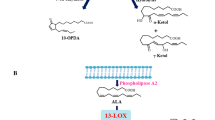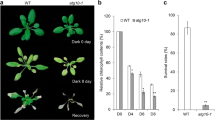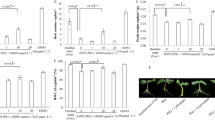Abstract
Recent evidence has proved that caspase protease activities are detected in both mammals and plants during programmed cell death (PCD). The characteristics and functions of caspase-like proteases play important roles in understanding the mechanisms of PCD in plants. In this work, we report firstly the involvement of caspase-like protease activities and effects in aluminum (Al) stress in two contrasting peanut genotypes. Caspase-like activities in the root tip cells of ‘Zhonghua 2’ (Al-sensitive) and ‘99-1507’ (Al-tolerant) were detected using synthetic caspase substrates during Al-triggered PCD. Caspase-1-, -2-, -3-, -4-, -5-, -6-, -8- and -9-like proteases were found in peanut root tip cells. VDQQDase (caspase-2-like) and WEHD (caspase-5-like) were the first detected in the plants, and almost all of the caspase-like proteases were activated during Al-induced PCD, especially caspase-3-like and caspase-1-like, which was higher in ‘Zhonghua 2’ than in ‘99-1507’. The highest activity levels of caspase-3- and caspase-1-like proteases occurred 8 and 4 h after 100 µM Al treatment, respectively. Compared with 100 µM AlCl3 treatment alone, specific caspase-3 protease inhibitor Ac-DEVD-CHO inhibited the increase of caspase-3-like protease activity, Al content, Hsr203j expression, cell death and DNA fragmentation, and the decrease in root growth induced by 100 µM AlCl3 treatment, but it was more obvious in ‘Zhonghua 2’ than in ‘99-1507’. In conclusion, there were different caspase-like proteases in root tips of peanut, and caspase-3-like protease was a crucial executioner in Al-induced PCD. Its effects in the ‘Zhonghua 2’ genotype were higher than in ‘99-1507’. An improved model of the mechanism of Al-induced PCD and Al tolerance differences in different genotypes is proposed.








Similar content being viewed by others
References
Anuradha TS, Jami SK, Datla RS, Kirti PB (2006) Genetic transformation of peanut (Arachis hypogaea L.) using cotyledonary node as explant and a promoterless gus:nptII fusion gene based vector. J Biosci 31(2):235–246
Behboodi BS, Samadi L (2004) Detection of apoptotic bodies and oligonucleosomal DNA fragments in cadmium-treated root apical cells of Allium cepa Linnaeus. Plant Sci 167(3):411–416
Biswas MS, Mano J (2016) Reactive carbonyl species activate caspase-3-like protease to initiate programmed cell death in plants. Plant Cell Physiol 57(7):1432–1442
Bonneau L, Ge Y, Drury GE, Gallois P (2008) What happened to plant caspases? J Exp Bot 59:491–499
Bosch M, Poulter NS, Perry RM, Wilkins KA, Franklin-Tong VE (2010) Characterization of a legumain/vacuolar processing enzyme and YVADase activity. Papaver Pollen Plant Mol Biol 74:381–393
Boscolo PRS, Menossi M, Jorge RA (2003) Aluminum-induced oxidative stress in maize. Phytochemistry 62:181–189
Cai MZ, Zhang SN, Xing CH, Wang FM, Zhu L, Wang N, Lin LY (2012) Interaction between iron plaque and root border cells ameliorates aluminum toxicity of Oryza sativa differing in aluminum tolerance. Plant Soil 353:155–167
Chen ZC, Zhao XQ, Shen RF (2010) The alleviating effect of ammonium on aluminum toxicity in Lespedeza bicolor results in decreased aluminum-induced malate secretion from roots compared with nitrate. Plant Soil 337:389–398
Chichkova NV, Kim SH, Titova ES, Kalkum M, Morozov VS, Rubtsov YP, Kalinina NO, Taliansky ME, Vartapetian AB (2004) A plant caspase-like protease activated during the hypersensitive response. Plant Cell 16:157–171
Coffeen WC, Wolpert TJ (2004) Purification and characterization of serine proteases that exhibit caspase-like activity and are associated with programmed cell death Avena sativa. Plant Cell 16:857–873
Coll NS, Vercammen D, Smidler A, Clover C, Van Breusegem F, Dangl JL, Epple P (2010) Arabidopsis type I metacaspases control cell death. Science 330:1393–1397
Danon A, Rotari VI, Gordon A, Mailhac N, Gallois P (2004) Ultraviolet-C overexposure induces programmed cell death in Arabidopsis, which is mediated by caspase-like activities and which can be suppressed by caspase inhibitors, p35 and defender against apoptotic death. J Biol Chem 279:779–787
De Jong AJ, Hoeberichts FA, Yakimova ET, Maximova E, Woltering EJ (2000) Chemical-induced apoptotic cell death in tomato cells: involvement of caspase-like proteases. Planta 211:656–662
del Pozo O, Lam E (1998) Caspases and programmed cell death in the hypersensitive response of plants to pathogens. Curr Biol 8:R896
del Pozo O, Lam E (2003) Expression of the baculovirus p35 protein in tobacco affects cell death progression and compromises N gene-mediated disease resistance response to tobacco mosaic virus. Mol Plant Microbe Interact 16:485–494
Fernandez MB, Daleo GR, Guevara MG (2012) DEVDase activity is induced in potato leaves during Phytophthora infestans infection. Plant Physiol Biochem 61:197–203
Fernandez MB, Daleo GR, Guevara MG (2015) Isolation and characterization of a Solanum tuberosum subtilisin-like protein with caspase-3 activity (StSBTc-3). Plant Physiol Biochem 86:137–146
Ferradas Y, Lopez M, Rey M, Gonzalez MV (2014) Programmed cell death in kiwifruit stigmatic arms and its relationship to the effective pollination period and the progamic phase. Ann Bot (Lond) 114:35–45
Ge ZQ, Yang S, Cheng JS, Yuan YJ (2005) Signal role for activation of caspase-3-like protease and burst of superoxide anions during Ce4+-induced apoptosis of cultured Taxus cuspidata cells. Biometals 18:221–232
Han JJ, Lin W, Oda Y, Cui KM, Fukuda H, He XQ (2012) The proteasome is responsible for caspase-3-like activity during xylem development. Plant J 72:129–141
Hatsugai N, Kuroyanagi M, Yamada K, Meshi T, Hara-Nishimura I, Nishimura M (2004) Vacuolar processing enzyme exhibiting caspase-1-like activity is involved in V-induced hypersensitive cell death in tobacco. Plant Cell Physiol 45:S143–S143
Hatsugai N, Iwasaki S, Tamura K, Kondo M, Fuji K, Ogasawara K, Nishimura M, Hara-Nishimura I (2009) A novel membrane fusion-mediated plant immunity against bacterial pathogens. Genes Dev 23:2496–2506
Hatsugai N, Yamada K, Goto-Yamada S, Hara-Nishimura I (2015) Vacuolar processing enzyme in plant programmed cell death. Front Plant Sci 6:234
Huang CF, Yamaji N, Chen Z, Ma JF (2012) A tonoplast-localized half-size ABC transporter is required for internal detoxification of aluminum in rice. Plant J 69(5):857–867
Huang WJ, Oo TL, He HY, Wang AQ, Zhan J, Li CZ, Wei SQ, He LF (2014a) Aluminum induces rapidly mitochondria-dependent programmed cell death in Al-sensitive peanut root tips. Bot Stud 55:e67
Huang WJ, Yang XD, Yao SC, LwinOo T, He HY, Wang AQ, Li CZ, He LF (2014b) Reactive oxygen species burst induced by aluminum stress triggers mitochondria-dependent programmed cell death in peanut root tip cells. Plant Physiol Biochem 82:76–84
Ishikawa S, Wagatsuma T, Ikarashi T (2003) Rapid changes in levels of mineral nutrients in root-tip cells following short-term exposure to aluminium. Plant Soil 255:245–251
Jang MG, Kim YJ, Jang GH, Sukweenadhi J, Kwon WS, Yang DC (2014) Ectopic overexpression of the aluminum-induced protein gene from Panax ginseng enhances heavy metal tolerance in transgenic Arabidopsis. Plant Cell Tissue Organ Cult 119:95–106
Keyster M, Klein A, Du Plessis M, Jacobs A, Kappo A, Kocsy G, Galiba G, Ludidi N (2013) Capacity to control oxidative stress-induced caspase-like activity determines the level of tolerance to salt stress in two contrasting maize genotypes. Acta Physiol Plant 35:31–40
Krzymowska M, Konopka-Postupolska D, Sobczak M, Macioszek V, Ellis BE, Hennig J (2007) Infection of tobacco with different Pseudomonas syringae pathovars leads to distinct morphotypes of programmed cell death. Plant J 50:253–264
Kumamaru T, Uemura Y, Inoue Y, Takemoto Y, Siddiqui SU, Ogawa M, Hara-Nishimura I, Satoh H (2010) Vacuolar processing enzyme plays an essential role in the crystalline structure of glutelin in rice seed. Plant Cell Physiol 51:38–46
Li Z, Xing D (2011) Mechanistic study of mitochondria-dependent programmed cell death induced by aluminium phytotoxicity using fluorescence techniques. J Exp Bot 62:331–343
Liu JX, Howell SH (2010) Endoplasmic reticulum protein quality control and its relationship to environmental stress responses in plants. Plant Cell 22:2930–2942
Lopez-Fernandez MP, Maldonado S (2013) Programmed cell death during quinoa perisperm development. J Exp Bot 64:3313–3325
Magalhaes JV (2010) How a microbial drug transporter became essential for crop cultivation on acid soils: aluminium tolerance conferred by the multidrug and toxic compound extrusion (MATE) family. Ann Bot (Lond) 106:199–203
Mallikarjuna G, Rao TSRB, Kirti PB (2016) Genetic engineering for peanut improvement: current status and prospects. Plant Cell Tissue Organ Cult 125:399–416
Matsumoto H, Motoda H (2013) Oxidative stress is associated with aluminum toxicity recovery in apex of pea root. Plant Soil 363:399–410
Nakamura M, Iketani A, Shioi Y (2011) A survey of proteases in edible mushrooms with synthetic peptides as substrates. Mycoscience 52:234–241
Pan JW, Zhu MY, Chen H (2001) Aluminum-induced cell death in root-tip cells of barley. Environ Exp Bot 46:71–79
Panda SK, Yamamoto Y, Kondo H, Matsumoto H (2008) Mitochondrial alterations related to programmed cell death in tobacco cells under aluminium stress. CR Biol 331:597–610
Panda SK, Baluska F, Matsumoto H (2009) Aluminum stress signaling in plants. Plant Signaling Behav 4:592–597
Qu GQ, Liu X, Zhang YL, Yao D, Ma QM, Yang MY, Zhu WH, Yu S, Luo YB (2009) Evidence for programmed cell death and activation of specific caspase-like enzymes in the tomato fruit heat stress response. Planta 229:1269–1279
Reape TJ, McCabe PF (2010) Apoptotic-like regulation of programmed cell death in plants. Apoptosis 15:249–256
Rodriguez-Serrano M, Barany I, Prem D, Coronado MJ, Risueno MC, Testillano PS (2012) NO, ROS, and cell death associated with caspase-like activity increase in stress-induced microspore embryogenesis of barley. J Exp Bot 63:2007–2024
Sanmartin M, Jaroszewski L, Raikhel NV, Rojo E (2005) Caspases. regulating death since the origin of life. Plant Physiol 137:841–847
Sun YL, Zhao Y, Hong X, Zhai ZH (1999) Cytochrome c release and caspase activation during menadione-induced apoptosis in plants. FEBS Lett 462:317–321
Tiwari V, Chaturvedi AK, Mishra A, Jha B (2015) An efficient method of agrobacterium-mediated genetic transformation and regeneration in local Indian cultivar of groundnut (Arachis hypogaea) using grafting. Appl Biochem Biotechnol 175(1):436–453
Twumasi P, Iakimova ET, Qian T, van Ieperen W, Schel JH, Emons AM, van Kooten O, Woltering EJ (2010) Caspase inhibitors affect the kinetics and dimensions of tracheary elements in xylogenic Zinnia (Zinnia elegans) cell cultures. BMC Plant Biol 10:162
Vacca RA, Valenti D, Bobba A, Merafina RS, Passarella S, Marra E (2006) Cytochrome c is released in a reactive oxygen species-dependent manner and is degraded via caspase-like proteases in tobacco bright-yellow 2 cells en route to heat shock-induced cell death. Plant Physiol 141:208–219
Wang H, Zhu X, Li H, Cui J, Liu C, Chen X, Zhang W (2014) Induction of caspase-3-like activity in rice following release of cytochrome-f from the chloroplast and subsequent interaction with the ubiquitin–proteasome system. Sci Rep 4:5989
Xu KD, Huang BY, Liu K, Qi FY, Tan GX, Li CW, Zhang XY (2016) Peanut regeneration by somatic embryogenesis (SE), involving bulbil-like body (BLB), a new type of SE structure. Plant Cell Tissue Organ Cult 125:321–328
Yamaguchi Y, Yamamoto Y, Matsumoto H (1999) Cell death process initiated by a combination of aluminium and iron in suspension-cultured tobacco cells (Nicotiana tabacum): apoptosis-like cell death mediated by calcium and proteinase. Soil Sci Plant Nutr 45:647–657
Yamamoto Y, Kobayashi Y, Devi SR, Rikiishi S, Matsumoto H (2002) Aluminum toxicity is associated with mitochondrial dysfunction and the production of reactive oxygen species in plant cells. Plant Physiol 128:63–72
Zhan J, Kou RJ, He LF (2008) Effects of aluminum on morphological structure of peanut root tips. Chin J Oil Crop Sci 30:79–83
Zhan J, He HY, Wang TJ, Wang AQ, Li CZ, He LF (2013) Aluminum-induced programmed cell death promoted by AhSAG, a senescence-associated gene in Arachis hypoganea L. Plant Sci 210:108–117
Zhan J, Li W, He HY, Li CZ, He LF (2014) Mitochondrial alterations during Al-induced PCD in peanut root tips. Plant Physiol Biochem 75:105–113
Zhang LR, Xu QX, Xing D, Gao CJ, Xiong HW (2009) Real-time detection of caspase-3-like protease activation in vivo using fluorescence resonance energy transfer during plant programmed cell death induced by ultraviolet C overexposure. Plant Physiol 150:1773–1783
Acknowledgments
This work was supported by the National Natural Science Foundation of China (Grant Nos. 31301249, 31560346 and 31260296) and the Guangxi Natural Science Foundation of China (Grant No. 2014GXNSFAA118074).
Author contributions
JZ and LFH designed and coordinated the study and revised the manuscript. SCY conducted caspase-like protease activities detection, caspase-3 inhibitor Ac-DEVD-CHO effects, DNA fragmentation, analyzed the data and wrote the manuscript. WJH conducted gene expression by RT-PCR. CLP cultured the plant and conducted the detection of TUNEL assay. All authors read and approved the final manuscript.
Author information
Authors and Affiliations
Corresponding authors
Ethics declarations
Conflict of interest
The authors declare that they have no competing interest.
Rights and permissions
About this article
Cite this article
Yao, S., Huang, W., Pan, C. et al. Caspase-like proteases regulate aluminum-induced programmed cell death in peanut. Plant Cell Tiss Organ Cult 127, 691–703 (2016). https://doi.org/10.1007/s11240-016-1064-8
Received:
Accepted:
Published:
Issue Date:
DOI: https://doi.org/10.1007/s11240-016-1064-8




